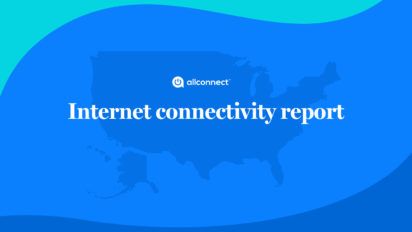Key findings:
- The average household consumes 652 GB of broadband data per month
- Users of gig speeds grew by 29%
- 5.3 billion people use the internet daily worldwide
- Power internet users who consume 2 TB or more per month increased by 37%
The world of online data and its usage is confusing. But, if you look at the numbers and make some real-world comparisons, the amount of internet data we are using may astound you.
For instance, did you know that, according to Teradata.com, “it has been estimated that 10 terabytes could hold the entire printed collection of the U.S. Library of Congress, while a single TB could hold 1,000 copies of the Encyclopedia Britannica?”
Of course, we most likely don’t need 1,000 copies of an encyclopedia at our fingertips, but that’s how much data some internet users are churning through monthly.
Monthly household broadband consumption 2010 to 2023
According to OpenVault’s Broadband Insights Report for the fourth quarter of 2023, the average household consumed 641 GB every month in the United States, up nearly 10% from the previous year and 652 GB on average for the entire 2023 year.
To put the report’s numbers into perspective, way back in 2010, the average surfer was using 9 GB a month. If we continue at the current pace, we’ll reach 700 GB by the end of 2024, and the average household will pass 1 TB per month by 2028.
Just so you’re aware, a 1 GB data plan can enable you to listen to eight hours of high-quality music from a service like Spotify without disruption, according to usmobile.com.
By the numbers
Here’s a list of data measurements from smallest to largest:
- Kilobyte (KB)
- Megabyte (MB) – 1,000 KB
- Gigabyte (GB) – 1,000 MB
- Terabyte (TB) – 1,000 GB
- Petabyte (PB) – 1,000 TB
Now, jump to 2024 and take a moment to realize that 1 TB equals 200,000 five-minute songs, 310,000 pictures or 500 hours worth of movies, according to Teradata.com, and that most of us are accessing over half of that already.
A Pew Research report released in 2024 stated that 95% of American adults use the internet, compared to about half of American adults in 2000.
“Today, eight-in-ten U.S. adults say they subscribe to a broadband internet service at home,” said Pew.
So more of us have access than ever before to download music, watch movies and more. We also have about 22 internet-connected devices in our homes that we frequently access, too, which also adds to the growing need for more data use at faster rates.
It’s not all about speed
Not only are internet users data-hungry, but we’re becoming speed freaks while also caring about the consistency and reliability of our connections. “Studies show that slow or inconsistent internet speed and repeated connection issues erode customer satisfaction and loyalty more than any other factor,” stated OpenVault’s report.
“Internet speed alone is not as much of a competitive advantage as it once was. Even gigabit subscribers experience lagging at unpredictable times. Surges in data usage demand will continue to impact network performance, which profoundly influences the customer experience. Studies show that slow or inconsistent internet speed and repeated connection issues erode customer satisfaction and loyalty more than any other factor.” In the fourth quarter of 2022, 26% of broadband users subscribed to speeds above 1,000 Mbps — also known as “gig speeds.” That was more than double the 12.2% in the same period of 2021.
A Pew report also found:
What does more data use mean to you?
With the number of internet users who hit a terabyte a month in data usage climbing, it is important to note that many major ISPs like Xfinity, Hughesnet and Cox have data caps set at 1 TB or lower, where, if exceeded, consumers would be on the hook for overage fees that can drastically increase a monthly internet bill.
As businesses and employees have learned to pivot operations to more remote work-at-home scenarios and automated online processes like banking and telemedicine, those numbers are still increasing. If you find that your internet plan is not keeping pace with your usage, here are some providers who offer unlimited data plans:
As the demand for more internet data – at faster speeds – increases, OpenVault’s conclusions recommend that ISPs study the trend and the value of unlimited data plans and gigabit speed options for their consumers.
Check out your internet speed here and figure how much speed do you really need for your household’s online use.
Allconnect: Let us compare providers for you
Why should you choose Allconnect? We’re the #1 broadband marketplace in the U.S, meaning you can trust us to search, compare and order internet and TV service for your home.
Get started
Written by:
Robin LaytonEditor, Broadband Content
Robin Layton is an editor for the broadband marketplace Allconnect. She built her internet industry expertise writing and editing for four years on the site, as well as on Allconnect’s sister site MYMOVE.com. …
Read more

Edited by:
Camryn Smith-
Featured
![100% of KS and RI residents have broadband access. Where does your state rank?]() 100% of KS and RI residents have broadband access. Where does your state rank? Joe Supan — 5 min read
100% of KS and RI residents have broadband access. Where does your state rank? Joe Supan — 5 min read -
Featured
![Should you be concerned about going over 1 TB of data?]() Should you be concerned about going over 1 TB of data? Robin Layton — 3 min read
Should you be concerned about going over 1 TB of data? Robin Layton — 3 min read -
Featured
![Could 4K streaming video and gaming quickly eat up your data limits?]() Could 4K streaming video and gaming quickly eat up your data limits? Joe Supan — 4 min read
Could 4K streaming video and gaming quickly eat up your data limits? Joe Supan — 4 min read
Latest
-
Thursday, July 25, 2024
Worried about losing your signal? This is how to keep your satellite dish cleanDavid Anders — 6 min read
-
Tuesday, July 23, 2024
The best free TV and movie streaming services 2024Camryn Smith — 5 min read
-
Tuesday, July 23, 2024
Everything you need to know about internet speedsRobin Layton — 8 min read






